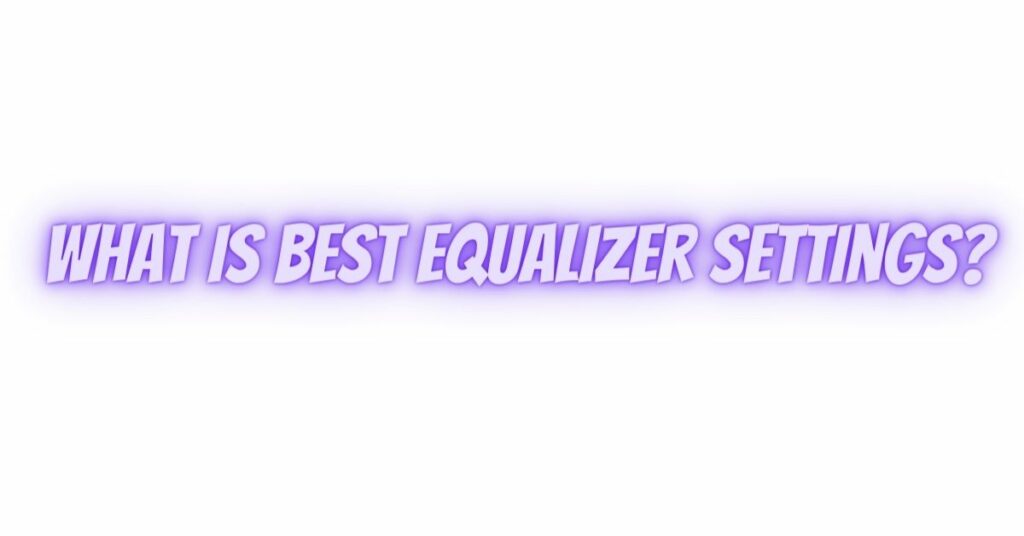Equalization, commonly referred to as EQ, is a powerful tool in the realm of audio and music. It allows you to adjust the balance of different frequency components in sound, ultimately shaping the character of your audio. Finding the best equalizer settings involves a blend of art and science, as it depends on various factors, including personal preferences, audio equipment, and the type of content you are listening to. In this comprehensive article, we will explore the principles of EQ and provide guidance on finding the best equalizer settings for your unique needs.
Understanding Equalization
Equalization is the process of altering the relative levels of different frequency bands in audio. An equalizer, whether a hardware device or a software tool, allows you to boost or cut specific frequencies, helping to balance and enhance the audio in various ways. The audible frequency spectrum is typically divided into several bands, including bass (low frequencies), midrange, and treble (high frequencies). Equalization permits control over these bands.
Factors Influencing Equalizer Settings
The best equalizer settings are influenced by various factors, each of which plays a role in determining the optimal configuration:
- Listening Environment: The acoustics of your listening space significantly affect the perceived audio quality. A well-treated room can reduce unwanted reflections and standing waves, affecting how you perceive the EQ settings.
- Audio Equipment: The type and quality of your audio equipment, including speakers, headphones, and amplifiers, can influence how different frequencies are reproduced. High-end equipment may provide more accurate sound representation.
- Content Type: The best EQ settings can vary depending on the type of audio content you are listening to. Music genres, movies, podcasts, and video games may benefit from different equalization profiles.
- Personal Preferences: Your individual taste and audio preferences play a significant role. Some listeners prefer a neutral, unaltered sound, while others may desire enhanced bass, detailed midrange, or crisp treble.
- Source Material: The quality of the source material, including the recording and production, can impact how you adjust your equalizer. Well-produced tracks may require minimal EQ, while poorly recorded content may benefit from corrective adjustments.
Finding the Best Equalizer Settings
While there is no one-size-fits-all solution for the best equalizer settings, the following guidelines can help you get started:
- Start Flat: Begin with a flat or neutral EQ setting. This means no boosts or cuts in any frequency band. This is often the ideal starting point, as it represents the most accurate and unaltered sound.
- Listen Critically: Play audio content you are familiar with and listen critically. Pay attention to areas where the audio may be lacking, such as weak bass, muddiness in the midrange, or excessive sibilance in the treble.
- Problem Solving: Use equalization to address specific issues. If you notice a lack of bass impact, consider a gentle boost in the lower frequencies. If the midrange sounds crowded or muddy, try cutting in the affected range.
- Subtractive EQ: In most cases, it’s a good practice to use subtractive EQ before boosting. Reducing frequencies that are problematic can often yield better results than boosting.
- Small Adjustments: Make small, incremental changes. Drastic boosts or cuts can lead to unnatural or distorted sound. Gradual adjustments allow you to fine-tune the audio without overcompensating.
- Use Your Ears: Trust your ears and listen as you adjust. What matters most is how the audio sounds to you. If it sounds good, it is good.
- A/B Testing: Compare your EQ settings to the flat or default setting. This helps you discern the impact of your adjustments and ensures that the changes are indeed an improvement.
- Save and Document: If your EQ settings are for a specific purpose or type of content, save and document them. This way, you can easily recall and apply them in the future.
- Experiment: Don’t be afraid to experiment. Different audio sources and genres may benefit from unique EQ settings. Explore various configurations until you find what suits your tastes and the specific audio content you are enjoying.
Conclusion
The quest for the best equalizer settings is a journey that involves careful listening, experimentation, and a deep appreciation for sound. While there are no universal settings that work for all scenarios, understanding the principles of equalization and considering factors like your listening environment, equipment, and personal preferences will guide you toward achieving the optimal audio experience. Remember that the best EQ settings should enhance and complement the audio without detracting from its natural beauty.


